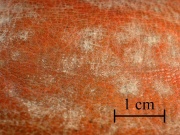Mold (fungus)
Description
Any of several types of fungi that cause a furry growth on the surface of plants and other organic materials. Mold beings as a white downy mass that is called mildew. It has a unicellular body with slender branching threads or hyphae. Mold reproduce by emitting millions of spore into the environment. The most common species are Aspergillus (black, yellow, and orange) and Penicillium (green). Molds can excrete organic acids, such as citric, oxalic, gluconic, etc., that can damage the growth substrate. This can result in discoloration of dyed textiles, paper, and leather. They also produce colored bodies that discolor materials. Mold growth can be inhibited by fungicides or minimized by a clean environment that has sunlight, dry circulating air and relatively low temperatures (Roberts and Etherington, 1982).
Synonyms and Related Terms
mildew; mould (Br.); Schimmel (Deut.); moisissure (Fr.); bolor (Port.)
Risks
- Molds can trigger allergic reactions in some people
Resources and Citations
- ICOMOS-ISCS: Illustrated glossary on stone deterioration patterns
- Mary-Lou Florian, Fungal Facts: solving fungal problems in heritage collections, Archetype, London, 2002
- E.McCrady, "Mold: The Whole Picture, Pt.1" The Abbey Newsletter, Vol. 23 (4), 1999. Link
- Matt Roberts, Don Etherington, Bookbinding and the Conservation of Books: a Dictionary of Descriptive Terminology, U.S. Government Printing Office, Washington DC, 1982
- Ralph Mayer, A Dictionary of Art Terms and Techniques, Harper and Row Publishers, New York, 1969 (also 1945 printing)
- Michael McCann, Artist Beware, Watson-Guptill Publications, New York City, 1979
- Hermann Kuhn, Conservation and Restoration of Works of Art and Antiquities, Butterworths, London, 1986
- Random House, Webster's Encyclopedic Unabridged Dictionary of the English Language, Grammercy Book, New York, 1997
- The American Heritage Dictionary or Encarta, via Microsoft Bookshelf 98, Microsoft Corp., 1998



